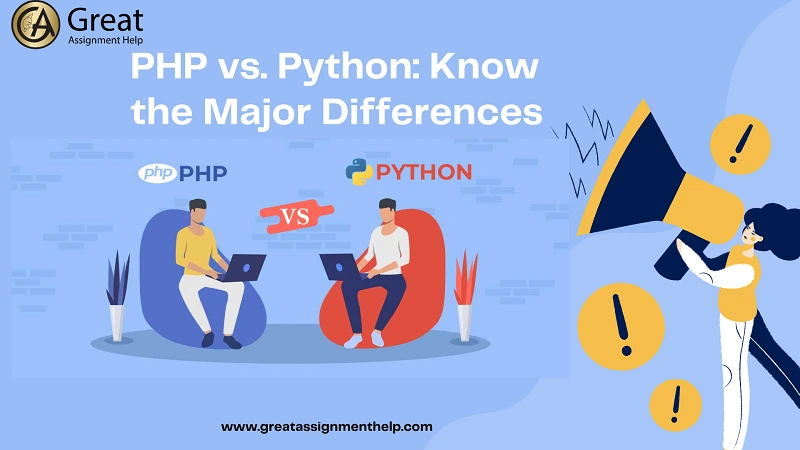PHP vs. Python: Which one to choose? PHP is ideal for web development, especially for building dynamic websites and web applications. Python is a versatile language. It can be used for web development, data analysis, and more. Both languages have their strengths. Hence, they are popular choices among developers.
In recent times, Python and PHP are the most popular programming languages that play a vital role in the development of websites and web applications. Even though both languages share some similarities, certain unique features of Python and PHP make them stand unique in the programming world. However, out of the two, some developers get confused about which language to choose for their project. If you also have the same doubt, then first get to know the differences between PHP and Python. Understanding the comparison will help you choose the right programming language according to your project requirements. In case you wish to learn how PHP is different from Python, read this blog. Here, we have presented a detailed comparative study of PHP vs. Python.
But, before we move on to see the comparison, first, let us have a look at a brief overview of PHP and Python.
What is PHP?
Hypertext Preprocessor (PHP) is an open-source scripting language that is used extensively for the development of dynamic websites and web applications. Originally, it was created by Rasmus Lerdorf, a Danish-Canadian programmer, in 1994 in the name ‘Personal Home Page’. Later, after some modifications, he released the first version of PHP in June 1995. Since then, the subsequent PHP versions have undergone various developments.
Basically, PHP is used for generating dynamic HTML content for the web. Also, it is helpful for the creation of XML documents, flash animations, images, and PDF files, among other things. Furthermore, it is easy to integrate PHP with all major web servers on almost all operating systems.
Features of PHP
The following are the primary features of PHP
- Free Open-Source
- Easy to use when compared to other scripting languages.
- Supports database integration with several databases, such as MySQL, Oracle, etc.
- Efficient and fast performance when compared to other scripting languages like JSP and ASP.
- Runs on almost all operating systems.
- Offers greater flexibility and embedding abilities.
- Easy integration with HTML, XML, JavaScript, etc.
- Contains predefined error reporting constants to create an error warning message.
- Provides access logging by generating a summary of recent user accesses.
What is Python?
Python is a high-level interpreted and object-oriented programming language that was developed by Guido Van Rossum in the year 1990. Basically, Python has a wide range of libraries and built-in data structures combined with dynamic typing and binding. Hence, it is primarily used for the rapid development of applications, standalone programs, and scripting algorithms for different domains.
Moreover, Python will also support modules and packages that allow for system modularity and code reuse. As it takes only a few lines of code, it is considered one of the fastest programming languages. Python mainly focuses on readability and simplicity, and thus it makes a good choice for beginners.
Features of Python
Listed below are the key features of the Python programming language.
- Free and Open Source Programming Language.
- Simple to learn, read, and maintain
- Runs on a variety of hardware systems by using the same interface.
- The Python interpreter supports the inclusion of low-level modules.
- Contains an excellent structure and support suitable for large programs.
- Possesses automatic garbage collection capabilities.
- Supports interactive testing and debugging.
- Allows dynamic type checking and provides high-level dynamic data types.
- Easy integration with Java, C, and C++ programming languages.
PHP vs. Python: Learn the Key Differences

Till now, we have seen a brief overview of PHP and Python. Next, in this section, let us look at the common differences between PHP and Python.
We Also Recommend: Python Language Advantages and its Applications
PHP vs. Python: Ease of Learning
PHP is an excellent scripting language that is suitable for developing dynamic web applications. Its syntax is similar to Java, C, and C++. In PHP, the variable names should be case-sensitive. Also, to write an error-free PHP source code, various rules and punctuation have to be followed. Therefore, it might take more time to learn PHP, especially for beginners.
When compared to PHP, Python is very easy to learn for people of all learning levels. It has a simple syntax and it uses simple English words instead of punctuation. Also, Python gives an accurate visual structure to its semantics.
PHP vs. Python: Ease of Installation
It is easy to install and run PHP on operating systems such as Windows, Linux, and macOS. On the other hand, Python is challenging to install. If a Python version is already installed on your macOS, then it will become even more difficult to install another version of Python. Moreover, for installing new Python packages, macOS requires the installation of a new Python version as well. In Windows also it is also tricky to install Python. But in Linux, Python installation is simple.
PHP vs. Python: Performance and Speed
Basically, the speed and performance will vary based on certain factors such as memory, storage space, hard disk access, code logic, and so on. But when compared to Python, the speed and performance of the latest versions of PHP is fast. However, the compilation process of Python’s code is quicker than the PHP version 6.
PHP vs. Python: Library Support
The library support for PHP is not so strong. However, Python 7 introduced Composer as its dependency manager. Hence, by pairing it with Packagist (a package repository for PHP), libraries can be managed efficiently.
On the other hand, Python offers excellent and mature support for libraries. Especially for package control, Python uses “Pip Installs Python” (Pip). Pip is fast and makes it easier to maintain libraries for a Python program. Also, Python contains some exceptional ML libraries such as TensorFlow, Keras, Scikit Learn, Theano, and many more mature libraries to develop AI and ML-backed web applications. Remember, all these libraries seamlessly integrate with web frameworks and are also fast, easy to use, and install.
PHP vs. Python: Flexibility, Scalability, and Versatility
PHP supports many powerful web frameworks like Symfony, Laravel, etc. Hence, it will be easy to develop, test, and manage web applications. However, when it comes to scalability, Python has an edge over PHP with its AI and ML capabilities that adapt to recent trends and scale as per demand. Also, in response to new trends and growing demands, even after some improvements, PHP is less flexible.
On the other hand, Python also offers a lot of web frameworks like Django, Flask, Pyramid, Pylons, TurboGears, etc. Also, it is better in library support. Therefore, Python is highly flexible, scalable, versatile, and simple to use.
PHP vs. Python: Security
When compared to PHP, Python is more secure. Specifically, Python provides several security features suitable for building complex applications with advanced functionality.
PHP vs. Python: Debugging
In PHP, debugging is not easy. It always requires an extra effort to complete the debugging process. However, to speed up the debugging process effortlessly, a PHP debugger like XDebug can be used. Like PHP, Python also contains an excellent debugger called Python Debugger (PDB). Furthermore, several PHP and Python debuggers, such as PyCharm or Visual Studio Code, can be integrated with IDEs.
We Also Recommend: Top 100+ Python Interview Questions
Difference between PHP and Python in Tabular Form
In the comparison table presented below, we have shared a few more differences between PHP and Python
| PHP | Python |
| It is a scripting language for web development. | It is a general-purpose programming language. |
| Complex syntax with a wide range of naming conventions. Hence tough to learn. | Simple syntax that is easy to use. Therefore, simple to learn. |
| Difficult to maintain. | Easy to maintain. |
| The performance of its latest versions is fast. | Relatively slower performance than PHP |
| Slow debugging process. | Fast debugging process. |
| Provides user access to around 20 databases. | Poor database integration. |
| Does not contain functional paradigms. | Supports functional programming methods. |
| Have faced several security attacks. | It is more secure because it contains a lot of built-in cybersecurity features. |
| Well-documented, but the old comments show up and create some confusion. | Well-documented and does not create confusion. |
| PHP is used for the development of web applications and web pages, the creation of Flash elements, e-commerce applications, and graphic design and image processing. | Python is used for the development of web applications along with emerging technologies such as artificial intelligence, machine learning, Big Data, etc. |
| Companies that use PHP are Facebook, WordPress, Yahoo, and Wikipedia. | Companies that use Python are YouTube, Pinterest, Instagram, Spotify, Quora, and Dropbox. |
PHP vs. Python: Which is Better for a Project?
The answer to this question highly depends on your project requirements as well as your coding skills, experience, and knowledge. Indeed, both PHP and Python are powerful programming languages suitable for website and app development. For a long time, PHP has been the go-to choice for the vast majority of web development projects. But, with its remarkable capabilities and functions for high-end science-based applications, Python is steadily making its way into this modern, tech-savvy world.
If you’re an experienced programmer looking to create a simple website with little intricacy, you can use either of them. However, if you’re a beginner, start with Python and then gradually move on to PHP or other languages. Remember, Python is the best choice for developing science-based applications and websites such as AI, ML, Big Data, and so on.
Conclusion
Hopefully, by now, you will have learned the difference between PHP and Python. In case you have any questions about PHP or Python concepts, or if you need project assistance from coding specialists, contact us quickly. Our team consists of several PHP and Python assignment help experts online. They will offer you cheap and the best Python and PHP assignment help services based on your needs. Especially, with the guidance of the programming assignment helpers from our platform, you can enhance your coding skills and improve your knowledge. This, in turn, will help you perform well in your academics and career.



